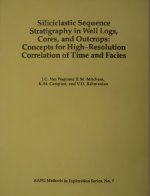Добрый день, Коллеги. Важное сообщение, просьба принять участие. Музей Ферсмана ищет помощь для реставрационных работ в помещении. Подробности по ссылке
Siliciclastic sequence stratigraphy in well logs, cores, and outcrops: Concepts for high-resolution correlation of time and facies / Стратиграфия кремнекластических последовательностей в каротаже скважин, керне и обнажениях
Концепции корреляции с высоким разрешением возраста и фаций
As the search for oil and gas becomes more sophisticated and producing basins and fields become more intensely developed, geoscientists need correspondingly more accurate techniques for stratigraphic analysis. To achieve this accuracy, companies are shooting higher-resolution seismic lines, acquiring 3-D seismic surveys over fields, and coring more to quantify reservoir properties. Exploration and production staff, provided with these more accurate but expensive data, often under-utilize the well log. In basins or fields with a sufficient density of well control, the coupling of conventional well logs and cores with the techniques of sequence stratigraphy results in an ultra-high-resolution chronostratigraphic framework for subsurface correlation. Where integrated with seismic and biostratigraphic data, well-log cross sections, interpreted using sequence and parasequence concepts, provide a state-of-the-art framework for analyzing reservoir, source, and seal distribution, whether on a regional or a field-reservoir scale. Sequence stratigraphy is the study of genetically related facies within a framework of chronostratigraphically significant surfaces. The sequence is the fundamental stratal unit for sequence-stratigraphic analysis. The sequence is defined as a relatively conformable, genetically related succession of strata bounded by unconformities or their correlative conformities (Mitchum, 1977). Sequence boundaries form in an increase in water depth. Parasequences and parasequence sets are the building blocks of sequences. A parasequence is defined as a relatively Present address: Sangree, Sneider, and Mitchum, Houston, Texas, U.S.A. conformable, genetically related succession of beds or bedsets bounded by marine-flooding surfaces or their correlative surfaces (Van Wagoner, 1985; Van Wagoner etal., 1988).<...>




